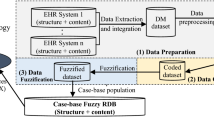Abstract
Rough sets are efficient for data pre-processing in data mining. Matroids are based on linear algebra and graph theory, and have a variety of applications in many fields. Both rough sets and matroids are closely related to lattices. For a serial and transitive relation on a universe, the collection of all the regular sets of the generalized rough set is a lattice. In this paper, we use the lattice to construct a matroid and then study relationships between the lattice and the closed-set lattice of the matroid. First, the collection of all the regular sets based on a serial and transitive relation is proved to be a semimodular lattice. Then, a matroid is constructed through the height function of the semimodular lattice. Finally, we propose an approach to obtain all the closed sets of the matroid from the semimodular lattice. Borrowing from matroids, results show that lattice theory provides an interesting view to investigate rough sets.



Similar content being viewed by others
References
Birkhoff G (1995) Lattice theory. Am Math Soc
Chen D, Zhang W, Yeung D, Tsang E (2006) Rough approximations on a complete completely distributive lattice with applications to generalized rough sets. Inf Sci 176:1829–1848
Dai J (2008) Rough 3-valued algebras. Inf Sci 178:1986–1996
Dai J (2005) Logic for Rough sets with rough double stone algebraic semantics. In: Proceedings of the 10th international conference on rough sets, fuzzy sets, data mining, and granular computing, pp 141–148
Dai J, Chen W, Pan Y (2006) Rough sets and Brouwer-Zadeh lattices. In: Proceedings of the 1st international conference on rough sets and knowledge technology, pp 200–207
Dai J, Xu Q (2013) Attribute selection based on information gain ratio in fuzzy rough set theory with application to tumor classification. Appl Soft Comput 13:211–221
Dai J, Xu Q, Wang W, Tian H (2012) Conditional entropy for incomplete decision systems and its application in data mining. Int J General Syst 41:713–728
Edmonds J (1971) Matroids and the greedy algorithm. Math Prog 1:127–136
Estaji A, Hooshmandasl M, Davvaz B (2012) Rough set theory applied to lattice theory. Inf Sci 200:108–122
Ghanim M, Mustafa H, Aziz S (2011) On lower and upper intension order relations by different cover concepts. Inf Sci 181:3723–3734
Gratzer G (1978) General lattice theory. Academic Press, New York
Gratzer G (1971) Lattice theory: first concepts and distributive lattices. W. H. Freeman and Company, San Francisco
Inuiguchi M, Hirano S, Tsumoto S (eds) (2003) Rough set theory and granular computing. In: Studies in fuzziness and soft computing, vol 125. Springer, Heidelberg
Lai H (2001) Matroid theory. Higher Education Press, Beijing
Lashin E, Kozae A, Khadra A, Medhat T (2005) Rough set theory for topological spaces. Int J Approx Reason 40:35–43
Lawler E (2001) Combinatorial optimization: networks and matroids. Dover Publications, New York
Lin T, Yao Y, Zadeh L (eds) (2001) Rough sets, granular computing and data mining. In: Studies in fuzziness and soft computing. Physica, Heidelberg
Liu G (2008) Generalized rough sets over fuzzy lattices. Inf Sci 178:1651–1662
Pawlak Z (1982) Rough sets. Int J Comput Inf Sci 11:341–356
Pawlak Z (1991) Rough sets: theoretical aspects of reasoning about data. Kluwer Academic Publishers, Boston
Pawlak Z, Skowron A (2007) Rough sets and boolean reasoning. Inf Sci 177:41–73
Pei D (2005) A generalized model of fuzzy rough sets. Int J General Syst 34:603–613
Qi G, Liu W (2005) Rough operations on boolean algebras. Inf Sci 173:49–63
Rouayheb S, Sprintson A, Georghiades C (2010) On the index coding problem and its relation to network coding and matroid theory. IEEE Trans Inf Theory 56:3187–3195
Stern M (1999) Semimodular lattices: theory and applications. In: Encyclopedia of Mathematics and its Applications
Wang S, Zhu P, Zhu W (2010) Structure of covering-based rough sets. Int J Math Comput Sci 6:147–150
Wang S, Zhu W, Min F (2011) Transversal and function matroidal structures of covering-based rough sets. Rough Sets Knowl Technol, pp 146–155
Yang L, Xu L (2009) Algebraic aspects of generalized approximation spaces. Int J Approx Reason 51:151–161
Yao Y (1998) Constructive and algebraic methods of theory of rough sets. Inf Sci 109:21–47
Zhu W (2007) Topological approaches to covering rough sets. Inf Sci 177:1499–1508
Zhu W, Wang S (2011) Matroidal approaches to generalized rough sets based on relations. Int J Mach Learn Cybern 2:273–279
Acknowledgments
This work is supported in part by the National Natural Science Foundation of China under Grant No. 61170128, the Natural Science Foundation of Fujian Province, China, under Grant Nos. 2011J01374 and 2012J01294, and the Science and Technology Key Project of Fujian Province, China, under Grant No. 2012H0043.
Author information
Authors and Affiliations
Corresponding author
Rights and permissions
About this article
Cite this article
Li, Q., Zhu, W. Closed-set lattice of regular sets based on a serial and transitive relation through matroids. Int. J. Mach. Learn. & Cyber. 5, 395–401 (2014). https://doi.org/10.1007/s13042-013-0176-2
Received:
Accepted:
Published:
Issue Date:
DOI: https://doi.org/10.1007/s13042-013-0176-2



